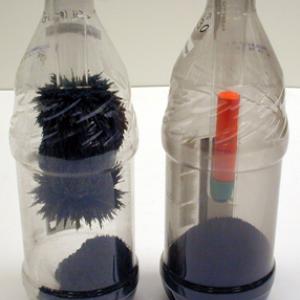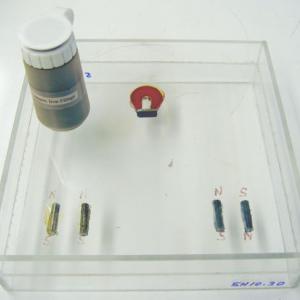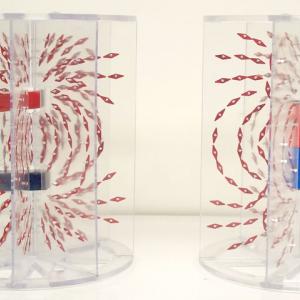College of Liberal Arts & Sciences
5H10.30 - Magnet and Iron Filings
Video Credit: Jonathan M. Sullivan-Wood
Place the magnets attached to the Plexiglas on the overhead and sprinkle on the iron filings. Tap the top of the plate to help align the filings. Observe the magnetic field lines.
3-D magnetic field lines may observed with the pop bottle arrangement.
CAUTION: Do not drop the magnets into the test tube as the bottom will break out. Slide the magnets gently into the test tube. These magnets may be removed from the apparatus after demonstration with the use of the small metal rods.
The magnetic field line demonstrations with the pointers allow you to view a 3-D representation of the magnetic field without the mess of the iron filings or ferrofluid.
Magnetic fields may also be viewed using the magnetic viewing film. This is particularly useful when trying to view the arrangement of flexible magnets or magnets that are not readily accessible.
- F. Behroozi, "Dancing Pins and Waving Flowers: Two New Demos for Visualizing Magnetic Field Lines", TPT, Vol. 59, #1, Jan. 2021, p. 66.
- Victor E. Henrich, "Wooly Willy: Distance Dependence of Magnetic Field", TPT, Vol. 57, #3, Mar. 2019, p. 196.
- Wilson Andrew Tillotson, Timothy McCaskey, Luis Nasser, "Teaching Representation Translations with Magnetic Field Experiments", TPT, Vol. 55, #1, Jan. 2017, p. 44.
- Alistair Kwan, "Historic Methods for Capturing Magnetic Field Images", TPT, Vol. 54, #3, Mar. 2016, p. 134.
- Mark Olson, "Common Magnets, Unexpected Polarities", TPT, Vol. 51, #8, Nov. 2013, p. 454.
- Silvia Defrancesco, Fabrizio Logiurato, and Grzegorz Karwasz, "GEOMAG™ Paradoxes", TPT, Vol. 45, #9, Dec. 2007, p. 542.
- Stephen Kanim and John R. Thompson, "Magnetic Field Viewing Cards", TPT, Vol. 43, #6, Sept. 2005, p. 355.
- Terence Cavanaugh and Catherine Cavanaugh, "Baking a Magnetic-Field Display", TPT, Vol. 36, #2, Feb. 1998, p. 84.
- Hugh Siefken, "Magnetic Field Mapping-Again", TPT, Vol. 35, #3, Mar. 1997, p. 181.
- Pangratios Papacosta, "How to Capture a Magnetic Field", TPT, Vol. 34, #7, Oct. 1996, p. 442.
- Richard Cannon, "Three-Dimensional Magnetic Field in a Bottle", TPT, Vol. 29, #5, May 1991, p. 311.
- Gary P. Johnson, "Magnetic Field Visualization on the Overhead Projector", TPT, Vol. 28, #4, Apr. 1990, p. 244.
- B. G. Eaton, "More About Casting Magnetic Lines of Force", TPT, Vol. 16, #4, Apr. 1978, p. 240.
- Mario Iona, "Casting Magnetic Lines of Force", TPT, Vol. 15, #6, Sept. 1977, p. 369.
- J. S. Huebner, "Observing Magnetic Field Lines in 3-D", TPT, Vol. 9, #6, Sept. 1971, p. 347.
- Francis S. Lestingi, "Projection Pointers: Magnetic Projections", TPT, Vol. 8, #3, Mar. 1970, p. 140.
- Philip E. Miller, "Three Dimensional Views of Magnetic Effects", TPT, Vol. 3, #7, Oct. 1965, p. 320.
- Rolla M. Dyer and Glenn F. Powers, "Apparatus for Teaching Physics: Three Dimensional Magnetic Field Demonstration", TPT, Vol. 3, #5, May 1965, p. 226.
- Kelley D. Sullivan, Antara Sen, M. C. Sullivan, "Investigating the Magnetic Field Outside Small Accelerator Magnet Analogs Via Experiment, Simulation, and Theory", AJP, Vol. 91, #6, June 2023, p. 432.
- Thomas B. Greenslade Jr., "Magnetic Model of the Earth", AJP, Vol. 76, #9, Sept. 2008, p. 811.
- L. Basano, P. Ottonello, and C. Pontiggia, "The Magnet-Solenoid Equivalence: A Modern Experiment Using a Personal Computer", AJP, Vol. 56, #6, June 1988, p. 517.
- Rainer Weiss and J. B. Grosh, "A Device to Display Magnetic Field Lines", AJP, Vol. 38, #6, June 1970, p. 777, also Apparatus Notes, July 1965-December 1972, p. 102.
- Ernst R. Czerlinsky, "The Display of Magnetic Field Lines", AJP, Vol. 36, #11, Nov. 1968, p. 1015.
- "B-010. Paper Clip Detector", DICK and RAE Physics Demo Notebook.
- G. D. Freier and F. J. Anderson, "Er-5", A Demonstration Handbook for Physics.
- G. D. Freier and F. J. Anderson, "Er-4", A Demonstration Handbook for Physics.
- Tik Liem, "Seeing Magnetic Lines", Investigation to Science Inquiry, p. 225.
- Robert Ehrlich, "M.4, Field of a Magnet", Turn the World Inside Out, p. 160.
- Robert J. Reiland, "#3, A Three Dimensional Magnetic Field Viewer", Teaching About Magnetism, p. 4.2.
- George M. Hopkins, "Magnetic Curves", Experimental Science, p. 354.
- Jearl Walker, "5.39, Earth's Magnetic Field and Archaeology", The Flying Circus of Physics Ed. 2, p. 236.
- Janice VanCleave, "Force Field", Physics for Every Kid - 101 Easy Experiments in Motion, Heat, Light, Machines, and Sound, p. 44 - 45.
- Janice VanCleave, "More Muscle", 202 Oozing, Bubbling, Dripping, & Bouncing Experiments, p. 95.
- Janice VanCleave, "Attractive", 201 Awesome, Magical, Bizarre, & Incredible Experiments, p. 10.
- Janice VanCleave, "12, Dipper", Magnets, p. 48.
- Janice VanCleave, "10, Plotting", Magnets, p. 40.
- Janice VanCleave, "9, Line Up", Magnets, p. 36.
- Janice VanCleave, "8, Which Way", Magnets, p. 32.
- Janice VanCleave, "6, Tug-of-War", Magnets, p. 24.
- Janice VanCleave, "2, More Muscle", Magnets, p. 8.
- Robert Ehrlich, "Field of a Magnet", Turning the World Inside Out, p. 160 - 161.
- R.D. Edge, "The Mysterious Magnet", String and Sticky Tape Experiments, p. 11.11.
- "Magnetic Lines of Force", Exploratorium Science Snackbook, p. 63.1.
- Ron Hipschman, "Black Sand", Exploratorium Cookbook II, p. 87.1.
- Tom Petruzzellis, "Detecting Magnetic Fields", Electronic Sensors for the Evil Genius, p. 161.
- Sara Stein, "Atom Magnets", The Science Book, p. 239.
- "Distribution of Magnetic Lines of Force Near the Surface of a Bar Magnet", Selective Experiments in Physics, CENCO, 1962.
- "The Inverse Square Law in Magnetism", Selective Experiments in Physics, CENCO, 1958.
- "Magnetic Moment and Magnetic Field Intensity", Selective Experiments in Physics, CENCO, 1958.
- Curt Suplee, "Attraction from Afar", Everyday Science Explained, National Geographic, p. 82 - 83.
- W. Bolton, "18. The Magnetic Field", Book 4 - Electricity, Physics Experiments and Projects, 1968, p. 36.
- Tik L. Liem, "The Mysteriously Moving Needle", Invitations to Science Inquiry - Supplement to 1st and 2nd Ed. p. 83.
- Rudolf F. Graf, "Magnetic Lines", Safe and Simple Electrical Experiments, p. 43.
- Rudolf F. Graf, "Demonstrating the Magnetic Lines of Force with a Compass", Safe and Simple Electrical Experiments, p. 44.
- Rudolf F. Graf, "How to Show Magnetic Field in Three Dimensions", Safe and Simple Electrical Experiments, p. 46.
- Borislaw Bilash II, “Force Fields“, A Demo A Day – A Year of Physical Science Demonstrations, p. 290.
- Joseph Frick, "#225 - Distribution of Magnetism", Physical Technics: Or Practical Instructions for Making Experiments in Physics and the Construction of Physical Apparatus with the Most Limmited Means, p. 250.
Disclaimer: These demonstrations are provided only for illustrative use by persons affiliated with The University of Iowa and only under the direction of a trained instructor or physicist. The University of Iowa is not responsible for demonstrations performed by those using their own equipment or who choose to use this reference material for their own purpose. The demonstrations included here are within the public domain and can be found in materials contained in libraries, bookstores, and through electronic sources. Performing all or any portion of any of these demonstrations, with or without revisions not depicted here entails inherent risks. These risks include, without limitation, bodily injury (and possibly death), including risks to health that may be temporary or permanent and that may exacerbate a pre-existing medical condition; and property loss or damage. Anyone performing any part of these demonstrations, even with revisions, knowingly and voluntarily assumes all risks associated with them.




